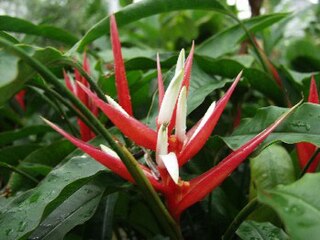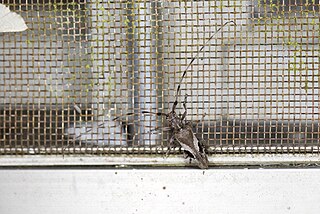
Heliconia angusta Vell., of family Heliconiaceae is an erect herb typically growing 0.70 m tall, native to Brazil.
St Andrew's School for Girls is an independent Christian girls school day and boarding school and co-educational preschool in Johannesburg in the Gauteng province of South Africa. The school has a student body of around 1100 girls.

Nacaduba angusta, the white lineblue, is a lycaenid butterfly found in South Asia. The species was first described by Herbert Druce in 1873.
Crepicephalus is an extinct genus from a well-known class of fossil marine arthropods, the trilobites. It lived from 501 to 490 million years ago during the Dresbachian faunal stage of the late Cambrian Period.

The Cuban slider is a species of turtle native to Cuba, but has also been introduced to Grand Cayman and Cayman Brac in the Cayman Islands, and Marie Galante in Guadeloupe.

Phalaris angusta is a species of grass known by the common names timothy canarygrass and narrow canarygrass. It is native to the Americas, where it is most common in Chile and Argentina and can be found in northern South America and sections of the southwestern and southeastern United States. It is also known as an introduced species in Australia. It grows in grassland, prairie, marshland, and other habitat.

Fissurella angusta is a species of sea snail, a marine gastropod mollusk in the family Fissurellidae, the keyhole limpets.
Dingana angusta, the narrow-banded widow, is a butterfly of the family Nymphalidae. It is found in grasslands the eastern highlands from northern Eswatini to Mpumalanga and the Limpopo Province.
Neptis angusta, or Condamin's sailer, is a butterfly in the family Nymphalidae. It is found in Ghana, the Democratic Republic of the Congo, western Uganda and north-western Tanzania.
Pelosia angusta is a moth of the family Erebidae. It was described by Otto Staudinger in 1887. It is found in the Russian Far East and Japan.

Pterolophia is a genus of longhorn beetles of the subfamily Lamiinae, containing the following species:
Anishus Angusta, Spesbona is a species of damselfly in the family Platycnemididae. This species was moved from the genus Metacnemis in 2013.

Uraecha angusta is a species of beetle in the family Cerambycidae. It was described by Francis Polkinghorne Pascoe in 1856, originally under the genus Monohammus. It is known from Vietnam, China and Taiwan. It contains the varietas Uraecha angusta var. horishana.
Aplogompha angusta is a Neotropical geometer moth species of the subfamily Ennominae. It is found in Panama.

Cuneolina is an extinct genus of prehistoric foraminifera in the family Cuneolinidae with species from the Jurassic and Cretaceous.
Pterostylis angusta, commonly known as the narrow shell orchid, is a species of orchid endemic to the south-west of Western Australia. As with similar greenhoods, the flowering plants differ from those which are not flowering. The non-flowering plants have a rosette of leaves flat on the ground but the flowering plants have a single flower with leaves on the flowering spike. In this species the flower is green, white and brown with an inflated base, a narrow hood and the longest labellum of any Western Australian Pterostylis species.
Elachiptera angusta is a species of frit fly in the family Chloropidae.

Helastia angusta is a moth of the family Geometridae. This species is endemic to New Zealand and has been observed in the Mackenzie and Otago Lakes districts of the South Island. The preferred habitat of this species is montane areas. Adults have been observed on the wing from October until December. As at 2000, the larval host species is unknown. It is classified as "At Risk, Relict'" by the Department of Conservation.

Kikihia angusta, the tussock cicada, is a species of cicada that is endemic to New Zealand. This species was first described by Francis Walker in 1850.








